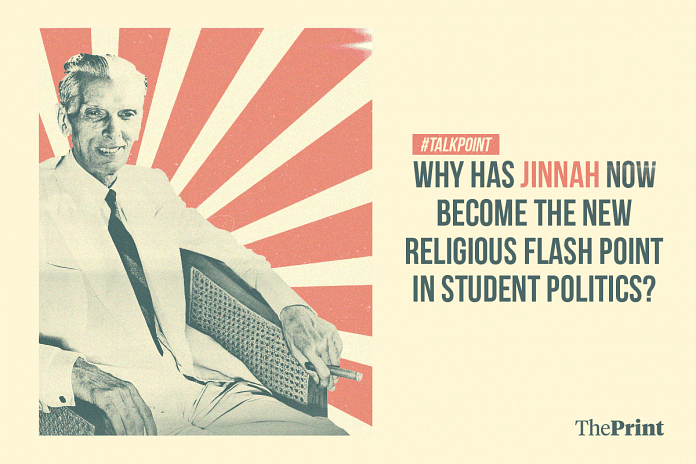A violent clash broke out in Aligarh over the removal of Muhammad Ali Jinnah’s portrait from Aligarh Muslim University (AMU). Forty-one people were injured in the incident.
Satish Gautam, the local MP, had written to the Vice-Chancellor and asked him to remove the portrait. Uttar Pradesh CM Yogi Adityanath has said Jinnah cannot be honoured in India. The university said that Jinnah had been granted a lifetime membership of the student union.
ThePrint asks: Why has Jinnah now become the new religious flashpoint in student politics?
How does AMU become ‘anti-national’ by keeping Jinnah’s portrait merely as a sign of its past?
 Sudheendra Kulkarni
Sudheendra Kulkarni
Former aide to former PM Atal Bihari Vajpayee, active in promoting India-Pakistan and India-China friendship
Falsification of history is the hallmark of all regimes and political parties that are dogmatic, intolerant of dissent, and coercive toward their opponents.
After Lenin’s death in the Soviet Union, Stalin systematically purged the Communist party of all those who were not his loyal supporters. Many of them, including very top leaders of the party, were killed. Moreover, even in those pre-photoshop years, the photographs of these leaders were erased from the official records of the party and the government.
Sadly, the BJP, for all its anti-communist rhetoric, seems to have some secret admiration for Stalin’s methods for rewriting history. This is evident from the needless, baseless and blatantly communal controversy its MP in Aligarh and some Hindu outfits have raked up by demanding the removal of a portrait of Muhammed Ali Jinnah from the Students’ Union Hall in the Aligarh Muslim University (AMU).
The portrait has been in there since 1938 (that is, before the Partition) when Jinnah was awarded life membership of AMU Students’ Union upon his visit to the university. Several other national leaders, including Mahatma Gandhi Jawaharlal Nehru, Maulana Abul Kalam Azad, were similarly honoured. His, and other leaders’, visit to AMU is a part of the university’s history. Why should the university be forced to disown and distort its own history? How does AMU become ‘anti-national’ by keeping the portrait merely as a sign of its past?
Indeed, Hindu communalists have been distorting history by projecting Jinnah as the sole villain of India’s division. Their own icons like Savarkar also advocated the two-nation theory. Dr S.P. Mookerjee, founder of the Bharatiya Jana Sangh (predecessor of the BJP) insisted on Bengal’s division. Their simplistic re-writing of history is intended to project themselves as the only true Indian nationalists, and also to repeatedly question the patriotism of Indian Muslims. The insinuation is – “Look, these Muslims continue to have sympathy for Pakistan because they still have a portrait of the architect of Pakistan in ‘their’ university.”
By their twisted logic, they should demand a ban on the song ‘Saare jahan se acchha Hindostan hamara’. After all, its creator Allama Iqbal, toward the end of his life, strongly advocated a separate homeland for Muslims in areas where they were in a majority and is therefore regarded by Pakistan as its National Poet. The poetic irony is this– the India-hating Pakistani counterparts of our own Pakistan-hating Hindu communalists wanted the song to re-written as ‘Saare jahan se acchha Pakistan hamara’!
Falsifiers of history everywhere are the same.
Media amplified Jinnah portrait controversy to suit BJP government
 Mohammad Sajjad
Mohammad Sajjad
Professor, AMU
First of all, given the current backdrop and genesis of the controversy, it is the BJP MP of Aligarh, Satish Gautam, who made it a political flashpoint by asking the AMU to take off an 80-year-old portrait in the hall of the AMU students union. The media took it up and amplified its decibel at a level that would be desired by the incumbent regime and its cohorts.
They are not able to face the people on concrete livelihood issues, as they have been failing quite miserably on those fronts. Therefore, they need divisive issues which they create by demonising and vilifying the Muslims and resorting to majoritarian consolidation for electoral gains. This helps them divert people’s attention from the crucial issues of the day.
Gautam was a member of the AMU Court, the highest decision-making body of the university. He chose not to raise the issue there. He is a lawmaker. He could have raised this issue in Parliament to make a law prohibiting any such portrait anywhere in the country. He chose not to do so.
The historical fact is: The portrait is hanging there since 1938 when Jinnah was made honorary life member of the students union. Pertinently, in the pre-1938 era, Jinnah was the ‘ambassador of Hindu-Muslim unity’ and was a freedom fighter. The first eminent person to have been conferred with this was Gandhiji, followed by many like Ambedkar, Maulana Azad, C.V. Raman, Rajendra Prasad, K.M. Munshi, Jai Prakash Narayan, Mother Teresa, and many more. Their portraits too are there in the AMU hall.
In February 2015, PM Modi inaugurated the Bombay High Court museum, showcasing Jinnah’s Barrister’s certificate along with Gandhiji’s and many more. The saffron forces didn’t protest then against the judicial preservation of history.
The AMU student union too did not play with, erase, or vandalise history. It preserved history. The portrait is certainly not there to glorify him or to be an inspiration. This accusation could have come only if the portrait appeared post-independence. This is in sharp contrast with Savarkar’s portrait in the Parliament that was installed in 2003. Savarkar is better known for his exclusionary and hate-filled nationalism, who justified rape and massacre as a political weapon in his book Six Glorious Epochs of Indian History. Yet, he remains an icon for some Indians.
Let the media and intelligentsia help build an inclusive Indian nation that marches forward on the path of progress and development.
AMU should be putting up a photograph of Savarkar instead of traitors like Jinnah
 Aamir Rasheed
Aamir Rasheed
Local RSS worker
The entire issue began after one of our student leaders filed an RTI seeking information on where the photographs of Muhammad Ali Jinnah have been put up in the Aligarh Muslim University. The reply clarified that there was a portrait in the Union Hall of the university.
The local representative then wrote a letter to the Vice-Chancellor demanding that the portrait is removed. It was a reasonable demand. But that’s where the entire debate began.
Even if he has been granted a lifetime membership in the university, the portrait must be removed. Jinnah is responsible for the death of thousands of Hindus and Muslims. He is responsible for the division of the country. What is it that the university is trying to assert by not removing his portrait? Statues of Bal Gangadhar Tilak and Bhagat Singh were demolished in Pakistan.
When they kept denying our request, the Hindu Jagran Manch got involved. They reached the university and burnt Jinnah’s statue. A mob of students then tried to attack us, demanding our arrest. The police reached the spot and had to do a lathi-charge to stop the protesters.
Now the pro-Jinnah faction is staging another protest to demand suspension of the SP and arrests of others. That is ridiculous. They should be putting up a photograph of Savarkar and cultivating nationalism instead of inspiring students with portraits of traitors like Jinnah.
This is all a local politician’s ploy to play dirty politics with AMU’s history
Mohammad Nadeem Ansari
Former Vice President, Students union AMU
Aligarh Muslim University has a rich cultural heritage. We have a past, we have a history and we will not surrender to goons. In 1920, Mahatma Gandhi was given a lifetime membership in the university. Our student union was pivotal in ensuring that he also received the title of Mahatma. Nearly 130 people have been granted lifetime membership in the university.
In 1938, when Jinnah received this honour, he was an Indian citizen. He was a revered freedom fighter. No one could have thought Pakistan would soon come into existence. It isn’t as if the portrait went up after Jinnah asked for a separate state.
This is nothing but a ploy on the part of Satish Gautam, the local MP. He just wants a ticket to contest the polls again. He is playing dirty politics with a portrait that is a part of the history of AMU.
We will not be party to his petty politics. The portrait will not be removed. It is the modus operandi of the RSS to effectively erase historical data they don’t agree with, and inert their own narrative in its place. The entire project is to change street names, decimate statues.
They are people dying in the country of hunger and these people want to play politics over a portrait? The RSS is neither a ‘Ram bhakt‘ nor a ‘rashtra bhakt’. All they do is destroy. They have been systematically trying to infiltrate universities from JNU to Jamia Milia Islamia, and now AMU. We will not let this happen.
BJP, RSS want to ‘fix’ AMU, just like they want to ‘fix’ JNU
 Sanya Dhinga
Sanya Dhinga
Reporter, ThePrint
Why would a portrait that has been hanging inconspicuously on a lone wall in a university for over eight decades become a national debate? This question that the students and the faculty of the Aligarh Muslim University are now forced to ask is strikingly similar to the question that students of Jawaharlal Nehru University asked two years ago. Why did slogans that some students shouted for years within the confines of their campus become a rallying point for ministers and politicians across the country to define nationalism? These issues cannot be looked at in isolation.
In AMU, for example, the Sangh had been trying to spread its roots since Yogi Adityanath’s government came to power in the state. While it is known that the current row is spurred by BJP MP Satish Gautam’s letter to the university Vice-Chancellor, little else is known.
It may be a tempting question to ask ‘why now?’, but it is also a misleading one.
To attribute the current battle on the campus to a specific reason would mean not noticing that this was always coming. Through my reporting in the university when I was there last month, students affiliated to right-wing organisations would admit that for the first time in the history of the university, they feel emboldened and protected enough to assert themselves openly. “Jab apni sarkar hai, toh darr kis baat ka?” is the popular sentiment. This reaffirms the agenda of BJP and RSS which is to ‘fix’ AMU just like it has been to ‘fix’ JNU. Jinnah’s portrait in itself is inconsequential, but its potential to draw battle lines on a campus ideologically far-removed from the Sangh is not. The BJP MP who wrote the letter knows this all too well.
Compiled by Deeksha Bhardwaj, journalist at ThePrint.
Illustration by Siddhant Gupta.








Why should Government enter the field of film awards? The state awards in vogue have been described as ‘irrelevant and unnecessary’. For the professions, there can be professional honours and no member of any profession, if he is eminent, can be judged except by his peers. The industry has its numerous awards.The government could help film industry in many other ways.